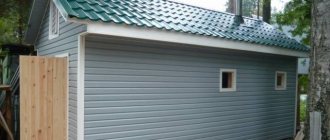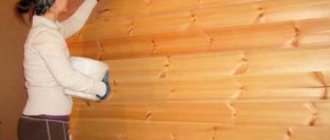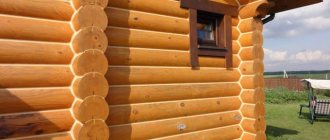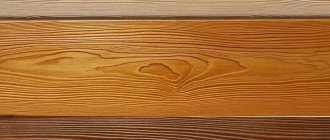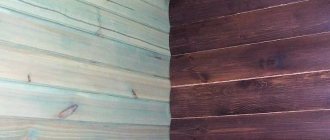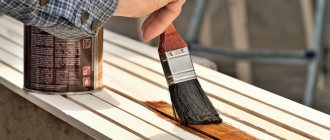Understanding the mechanisms of wood decay has made it possible to counteract this process. Since its main initiator is various fungi, man has created means that destroy them.
Along the way, other means were developed that also increased the safety of the tree and its ability to resist pests. The bathhouse, being a place with high humidity, is the most vulnerable and needs protection. True, with great reservations, because protective antiseptics are poisons , the use of which in a bathhouse is undesirable. But compromises are possible here too.
Below we will analyze the types and uses of antiseptics for baths and saunas, and also conduct our own research on which bath antiseptic is better to use inside and which outside.
Briefly about the main thing
To process lining in a bathhouse, materials that are resistant to temperature changes, humidity, and washing are used.
Also important is inertness to fungus, mold, bacteria, and a safe composition for humans. When heated, many materials release toxins and other harmful substances, so the use of antiseptics, fire retardants, drying oils, varnishes with solvents and acrylic resins is unacceptable for the steam room.
For walls and ceilings, impregnations, mastics, oils and some varnishes are used. For shelves only oil or wax based formulations. This prevents the formation of a thick film to avoid burns.
Bleach is used in any room of the bathhouse, but before further processing of the wood, it is necessary to wait until the chlorine evaporates and the hydrogen peroxide decomposes.
Antiseptics and fire retardants are classified as pre-treatment agents for wood, but are not used as independent coatings. They protect the lining and help reduce the consumption of the finishing coating.
Source
Quarantine zones inside the bathhouse
First of all, it is worth deciding how and where to properly use the antiseptic inside the bathhouse. Any bathhouse consists of at least four main rooms:
- Entrance room and locker room;
- Restroom;
- Washing or shower rooms;
- Steam room.
Inside each room of the bathhouse there are completely different conditions, therefore the methods of using antiseptics or disinfectants are completely different.
Inside the dressing room and hallway, the conditions are approximately similar, so to treat wood cladding and especially the floor, you can and should use the usual antiseptic options for interior living rooms. The higher quality the drug, the better. You can use the antiseptic Senezha, Neomid or more expensive Finnish preparations for working inside buildings manufactured by Tikkurila.
With proper ventilation and regular sanitary treatment of the wooden floor and walls, fungus or blue rot, any similar pathogenic microflora, even after a single high-quality treatment with an antiseptic in these rooms inside the bathhouse, is doomed to destruction.
Types of impregnations
Generally speaking, on the building materials market you can find four types of water-repellent impregnations for wood.
- Dry or concentrated (to be diluted with water)
- Organic;
- Mixed;
- Oil (or oil-based);
Water-based impregnations are more suitable for treating the dressing room. Organic compounds are quite effective in protecting wood. They are distinguished by their ability to create a durable protective film. Mixed impregnations usually also contain fire retardant reagents.
Oil based products usually contain wax or paraffin. By the way, judging by the reviews of many bathhouse owners, specialized floor oil from a “foreign” manufacturer is very effective...
Method of application
Important: before starting the process, the floor must be well dried;
Protective agents are applied in layers. Be sure to carefully process cuts, edges and damaged areas.
Important: processing and drying is carried out at warm temperatures and low humidity;
If your boards have already begun to be chewed by wood bugs, then disinfect them with special means before applying water-repellent impregnation.
Important: when processing, do not limit yourself to the gnawed holes, cover the area in and around them. Advice: carefully read and follow the instructions given by the manufacturer!
Advice: carefully read and follow the instructions given by the manufacturer!
It’s a shame if the purchased product and the time spent on its use go down the drain; because of simple laziness, you read the text on the package.
Remember, a good (in terms of the manufacturer and correct use) antiseptic can increase the “vitality” of the wooden floor of your bathhouse, up to 10 years.
Anecdote about gender. “A good walk is when you wake up on the floor and see that you’ve been circled with chalk.”
Dear reader, the topic that I tried to open up is quite relevant and has different points of view. One thing is unshakable - the bathhouse makes us forget or distract ourselves from everyday worries, gray work days, the electrified atmosphere of offices and family troubles
This means you should pay attention to your favorite leisure time.
Subscribe, read and introduce your friends to the blog. We sincerely try to make it alive and relevant. Good luck!
Wisdom Quote: To be a hero also means to fight against the all-powerful fate.
Oils and impregnating compounds for lining in steam rooms
To protect the lining from the negative effects of high temperatures and humidity, safe and effective compounds are used. For decorative finishing of the steam room, aspen, oak and linden lining is used. How can this type of wood be treated to improve its performance?
For these purposes, impregnations and natural oils are used - sunflower, hemp, linseed, rose, lavender and anise. This treatment allows you to create a protective coating that prevents dirt from penetrating into the wood fibers and protects against rotting.
Deep penetration impregnation for lining has similar properties, which provides maximum protection of wood fibers from destruction.
To prevent the lining from darkening or rotting, reliable and safe preparations of imported and domestic production are recommended for processing.
The products of the famous Tikkurila brand are especially popular:
- Saunasuoja Supi is an acrylic water-based impregnation that provides protection against mold and darkening. It has a colorless structure, but can be tinted to suit any shade. The composition is applied to a clean surface with a brush or spray in several layers. Not used for treating bath furniture.
- Laudesuoja Supi – oil-based impregnation for treating wall surfaces and furniture.
- Saunapesu Supi is an antiseptic impregnation for removing lime deposits and bleaching wood.
Among the domestic analogues, the following drugs can be distinguished:
- "Eurotex Sauna" is a wood oil that provides protection against increased moisture and rot.
- “Usadba (U 409)” is an impregnating composition that prevents contamination and darkening of wooden surfaces.
Door protection
In a sauna, as a rule, there are several rooms with different purposes. You can use a door to separate the washroom from the locker room. This element requires special care aimed at preserving its original appearance and extending its service life. For wooden panels, this requirement takes on special significance.
Doors purchased for saunas most often already have treatment against rotting. Therefore, additional impregnation from moisture is not required. Most often, canvases are painted.
How to paint the doors leading to the sink? The dye must meet the following requirements:
- protect the wood from the sauna temperature;
- extend service life;
- provide aesthetic appeal.
To paint the door, it is recommended to use special wood varnishes. They have the following advantages:
- high level of vapor permeability (similar to antiseptic treatment);
- the ability to repaint the surface;
- a wide selection of pigments that can highlight the natural texture of wood.
Often, a stain is used to treat a door made of natural wood, which also helps solve the problem of protecting the surface
It is important to remember that large imperfections are filled with a special compound. Its color is selected in accordance with the shade of the varnish, oil or stain used
How to cover other elements
It is very important to treat benches, shelves and other pieces of furniture in the bathhouse. This will increase the service life of the products and prevent burns on the human body as a result of contact with hot surfaces
Water should not be absorbed into the wood, and at the same time, there is no need for a varnish film on the surface of objects, which, when heated, leads to burning of the skin. This coating is provided by special oils for sauna shelves, including “Supi Laudesuoja” (Tikkurila) or “Sauna Oil” (Eskaro).
Don't forget about windows and doors. The effects on these interior elements differ in each individual place of the bath:
- Window and front door. Outside temperature up to -30. Internal temperature +20;
- Door from the relaxation room to the steam room. The temperature in the room is +20, and in the steam room up to +12;
- The door from the locker room to the sink. There is normal humidity in the locker room, and water may flow down the door in the sink.
A suitable coating that can withstand such changes in temperature and humidity for a long time can only be industrial. The three-component polyurethane (varnish, hardener, thinner) system “D-Dur” (Akzo Nobel) is successfully used to protect windows and doors operated in aggressive conditions.
Strict supporters of ecology will be pleased with the technology by the presence of certificates that allow the use of varnish not only in baths, but also for more strict structures (children's furniture and toys, children's wooden utensils used for boiling water, etc.). Pinotex Base antiseptic from the same manufacturer is used as a penetrating primer.
Which is best
Since ancient times in Russia, wax, as well as hemp or linseed oil, have been used to treat bathhouses. Despite the modern processing compositions proposed by various manufacturers, it is possible to use time-tested products and, at present, they have not lost their relevance.
Of the modern substances, it is best to use acrylic types of varnishes, as well as water- and wax-based varnishes. The advantage of these products applied to boards is that they do not release harmful, toxic substances and pungent odors when heated, which are formed by standard varnishes and paints. This is especially true for treating sauna steam rooms with compounds, where the walls, ceiling and floor are made of wooden paneling and where colorless varnish is best suited.
What to do to extend the life of a tree?
Impregnation for sauna
A difficult question for bathhouse owners (I think I came up with a new term). Many people do not want to subject their pleasant golden wood to treatment with synthetic materials. Why? They believe that this disturbs the microclimate (you know, heated boards “breathe”, release phytoncides, a natural aroma, and “chemistry” kills all this). By the way, our great-grandfathers did not bother about this at all. They simply re-laid the floors, and at the same time the walls.
Now times are different and special antiseptics for baths have appeared on the market, designed for exposure to high temperatures. If you believe manufacturing companies, such as the Finnish Tikkurila, they do not emit harmful fumes.
It’s probably worth giving up the prejudice that wood for a bath should not be treated with anything. In the end, we breathe in air that is far from the same as it was 200 years ago, and the food we eat is not at all purely organic, and now our forest does not grow outside our garden (although others do).
Useful video
The video below advertises “Neomid 200”:
But Tikkurila made an advertising video that talks about what affects wood and how to deal with it - from products to application technology:
***
Have you ever used any antiseptic in your bath? If yes, share your experience and impressions in the comments.
By the way, there is still a lot of interesting things on our website. For those who would like to keep abreast of updates, we recommend subscribing to our channel on Telegram.
Copper sulfate treatment
This method is distinguished by its accessibility, because its price is quite low. The disadvantage of copper sulfate is its toxicity, which increases with heating, so it can only be used for external treatment of the bath.
To treat a bathhouse with copper sulfate you will need:
- Brushes;
- Protective equipment (rubber gloves, thick clothing and a respirator);
- Brushes with stiff bristles.
Treating the outside of the bathhouse frame with copper sulfate:
- Clean and dry the wooden surface;
- Apply copper sulfate and rub it in thoroughly;
- Wait for it to dry and apply another 3-4 layers.
Conclusion
Now you know what is used to treat a log house in a bathhouse, outside and inside. Treatment will significantly increase the service life of wood, so the time and effort spent on processing will not be wasted.
Recommendations for processing wooden surfaces
When processing wooden surfaces, you should follow simple rules:
- The main condition that must be strictly followed is that the surface treated with an antiseptic must be clean and dry. Remember: cleanliness is the key to success. First, remove stubborn dust, dirt, varnish residues, etc.
- The treatment should be carried out after the surface has been thoroughly sanded; it should be smooth, without cracks or knots.
- Monitor the temperature in the bathhouse or sauna; it cannot be lower than 10 degrees.
- Humidity not less than 80%. Changes are undesirable. This will affect the quality of processing and drying time.
- The antiseptic is applied with a brush or spray gun. The syringe is used for hard-to-reach places.
Treatment of walls and ceilings
The walls and ceilings of baths and saunas are certainly finished with wood. The most common means is lining made from deciduous trees. Their wood is not very dense and has low thermal conductivity. When heated, the walls of the steam room, lined with wooden clapboard, do not get very hot and do not burn the skin. The walls and ceiling of the steam room are subject to high temperatures and high humidity. This has a negative effect on the wood. It warps, cracks, darkens, and fungus and mold form. Therefore, the walls and ceiling must be treated with an antiseptic.
There are many means for treating the walls and ceiling of a bathhouse. A water-borne aniseptic based on acrylic is most suitable for these purposes; it forms a transparent coating on the surface. It is water-dirt-repellent, breathable, and heat-resistant in its properties. Protects wood very well and destroys microbes.
The Sauna product can preserve the walls and ceilings of baths and saunas well. It is translucent, leaves the natural grain of the wood visible and enlivens the interior.
You can cover the walls and ceiling of the bathhouse with Supi Arctic protective agent from Tikkuril.
Processing shelves and benches
What kind of protective equipment should be used to treat shelves and benches in bathhouses and saunas? Why can’t you use one product, but you need different impregnations?
Currently, numerous antiseptics have been developed for treating sauna and bathhouse wood.
There are impregnations for shelves and benches that do not cause burns upon contact with the skin. Shelves (or floors) and benches should be treated with impregnations that penetrate well into the wood structure and do not form a film on its surface, as varnish does. Dry wood has low thermal conductivity, and even at a temperature of 100 ° C it does not seem very hot. And if the shelf is varnished, then burns cannot be avoided at this temperature.
Thus, sauna and bathhouse shelves should be treated with oil compounds such as Sauna Natura, Supi Laudesuoja, etc.
The most problematic place in a sauna is the floors. An antiseptic for the floor in a bathhouse must be well absorbed into the wood. One of the universal remedies is a composition with natural wax from. It can be used on the ceiling, steam room floor, and on shelves, benches, and window frames. Penetrating deep into the pores, it protects it from moisture, dirt, and cracking. The emulsion is made on the basis of vegetable oils. It can be applied to all types of wood, even heat-treated.
After a certain time, the effectiveness of antiseptics decreases, which means that disinfectants are an additional means of combating fungus indoors.
How to treat a steam room?
This room is significantly different from other bathhouses. The wood paneling must first be thoroughly dried in a microwave dryer. This way, without any chemicals or special products, insect larvae, bacteria, viruses, and mold are destroyed inside the wood. This is the so-called thermal hardening, which is mandatory for bath boards.
Before starting finishing work, it is important to treat the underside of the boards, wooden floor joists, and floor covering several times. It is best to cover the ceiling structure with antiseptic wax and the floors with varnish.
They try to leave the walls themselves as they are. Firstly, a dense coating will prevent the release of natural resins and aromatic substances from pine, spruce, and alder. Secondly, under the influence of high humidity and temperature, the chemical compounds that make up the antiseptic can evaporate. The best way to treat the walls of a steam room is considered to be dry hot steam at maximum temperature (“roasting”) and through ventilation of all rooms so that moisture does not stagnate anywhere.
The Wood-Brus company offers not only construction services for wooden houses, log cabins and bathhouses on a turnkey basis, shrinkage basis, using frame technology in Moscow and the region, but also their subsequent treatment with special compounds of internal and external wooden surfaces. This will save you a lot of time, money and effort. Our specialists have been working in the market for about 20 years and during this time they have perfected the processing technology
For concrete
It’s easier with concrete than with oven bricks. Concrete is not associated with high temperatures; it is most often protected from destruction under the influence of water.
For this purpose, water-repellent impregnations can be used. There are quite a lot of them, they provide the formation of a layer on the surface that prevents it from being wetted by water.
In addition, there is a whole range of impregnations designed not only to make the surface waterproof, but also to increase the strength and other characteristics of concrete. It’s unlikely that all of them can be useful in a bathhouse, but it’s worth listing them:
- Polyurethane impregnation for concrete in a bathhouse is an acceptable option, not too expensive. Layer depth up to 4 mm.
- Deep penetration impregnation - provides very high strength to concrete bases, but it is not necessary for a bathhouse.
- Epoxy impregnation is two-part, odorless, forms a layer of 1-2 mm.
- Acrylic is a cheap option, suitable for lightly loaded concrete surfaces.
- Fluate impregnation - eliminates efflorescence because it binds free calcium inside concrete and brick. We also don’t see much use for it in the bathhouse, if we are talking about concrete.
In general, for a concrete floor, a water repellent or polyurethane impregnation will do; for a drain under the floor, a water repellent is sufficient, because there is no load on it at all.
What should you consider when choosing?
Modern manufacturers offer many different products for wood processing. Before choosing an impregnation, you should identify the purpose of its use:
- painting object;
- preservation of natural texture, tinting or painting;
- level of moisture resistance of the room;
- applying the product to the surface.
Impregnation for wood must have many qualities, the main thing is to provide the material with reliable protection and not reduce its ability to pass air. When decorating the interior of a room, the environmental friendliness of the product is very important.
This quality is especially important if there is high humidity indoors. Such conditions will provoke the release of harmful impregnation components.
There are special requirements for wood impregnations. After coating the surface, there should be no film left on it. When the temperature in the bath increases, the coating should not release components harmful to health.
Types of antiseptics
Manufacturers today offer several types, from which it will be possible to determine the best antiseptic for a bath.
- Water soluble. Their purpose is to process wood that is not used in wet areas and does not come into contact with water. That is, it is not used for baths.
- Oily. This is the most durable antiseptic that forms a protective film on the surfaces being treated. It, in turn, does not allow moisture to enter the wood body. The material contains several types of oils that have an unpleasant, pungent odor. It is for this reason that oil antiseptics are used for external treatment. For example, you can use them to treat the external surfaces of the walls of a wooden bathhouse or wooden pillars and foundations.
- Organosoluble. It is also used for external use because the material contains an element such as copper pentachlorophenol naphthenate. This substance is practically considered poison.
- Combined. This, as they say, is two in one. That is, this material has both antiseptic and fireproof properties.
